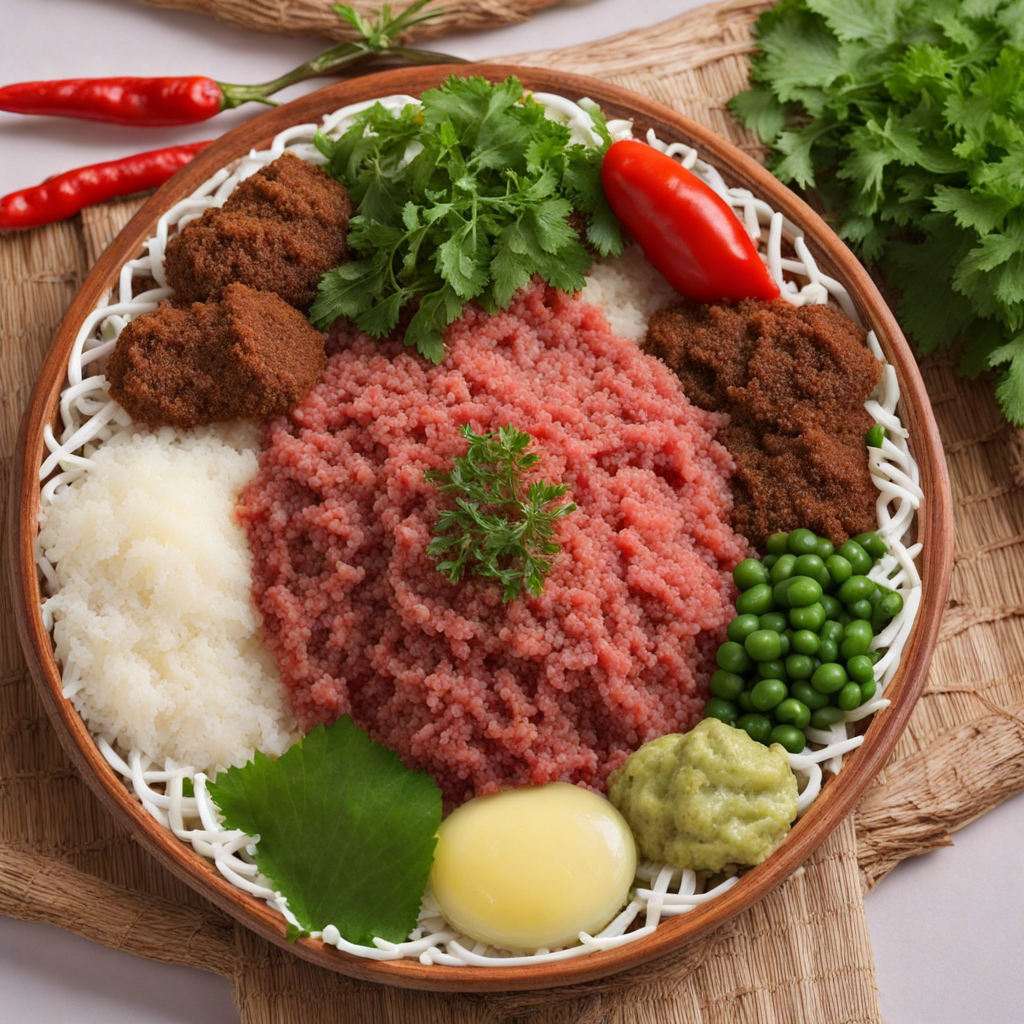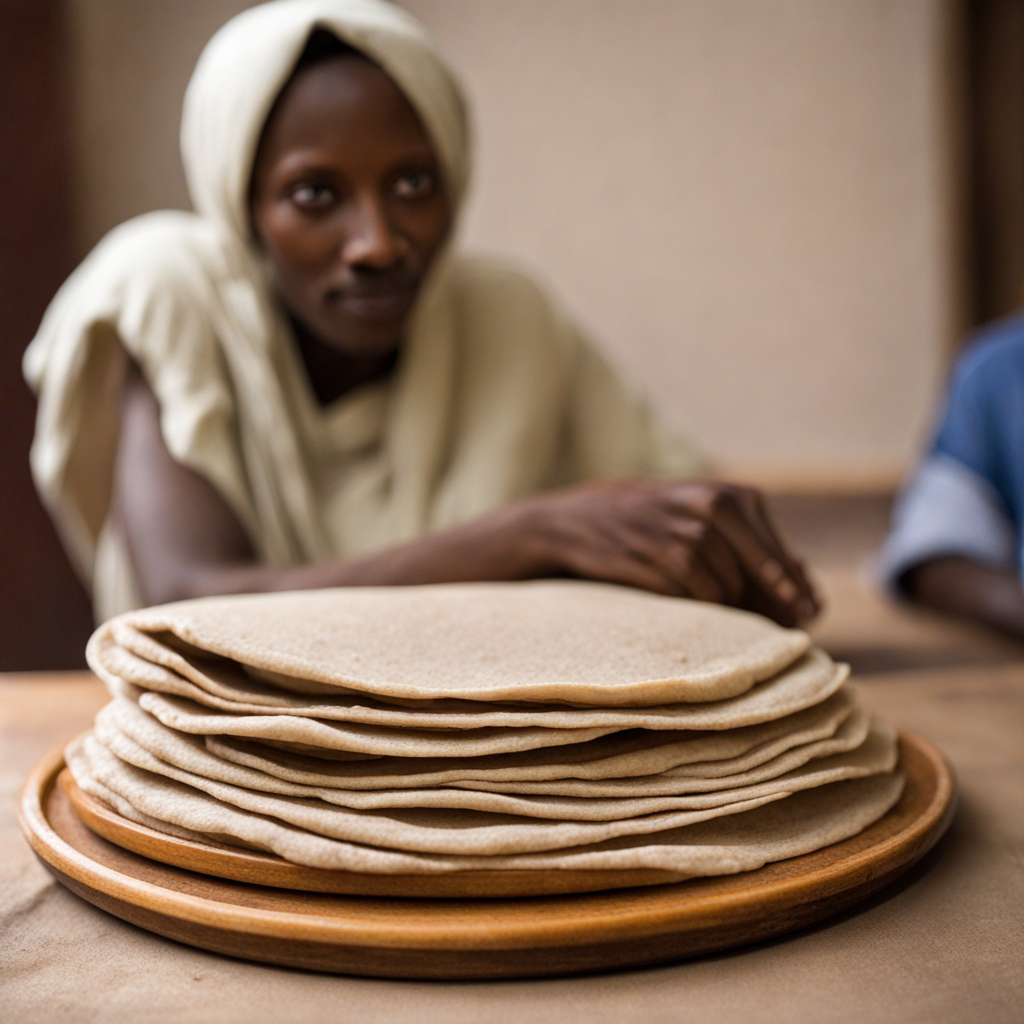Kitfo
Kitfo is a traditional Ethiopian dish that showcases the country's rich culinary heritage. At its core, Kitfo consists of raw minced beef, typically sourced from high-quality cuts, which is seasoned with a blend of spices and clarified butter known as 'ghee' or 'kibe.' The meat is often mixed with mitmita, a spicy chili powder, and sometimes served with a touch of ayib, a fresh cheese, to balance the robust flavors. This dish is not only a sensory delight but also a reflection of Ethiopia's vibrant culture, where communal dining and sharing food are integral to social gatherings. One of the unique aspects of Kitfo lies in its preparation and serving style. It can be enjoyed in various forms, from completely raw (known as 'kitfo gored gored') to lightly cooked (known as 'kitfo lebleb') depending on personal preference. The dish is traditionally accompanied by injera, a spongy sourdough flatbread made from teff flour, which acts as both a side and a utensil for scooping up the flavorful meat. The combination of the tender beef, the rich spices, and the tangy injera creates a harmonious balance that tantalizes the palate. Kitfo is often enjoyed during special occasions and celebrations, making it a dish that carries a sense of festivity and communal joy. Its bold flavors and rich textures invite diners to explore the depths of Ethiopian cuisine, while the use of fresh, high-quality ingredients highlights the importance of sourcing and sustainability in the region's culinary practices. As you delve into the world of Kitfo, you'll discover not only a new taste experience but also a deeper appreciation for Ethiopia's diverse food culture.
How It Became This Dish
The History of ክትፎ (Kitfo): Ethiopia’s Culinary Gem #### Origins of Kitfo Kitfo, a traditional dish that epitomizes Ethiopian cuisine, is essentially minced raw beef seasoned with spices and served with a variety of accompaniments. Its origins can be traced back to the Gurage people of Ethiopia, a group known for their rich culinary traditions and unique flavor profiles. While the exact timeline of Kitfo’s emergence is difficult to pinpoint, it is widely believed to have roots that stretch back several centuries, intertwining with the agricultural practices of the Ethiopian highlands, where cattle herding formed an integral part of life. Historically, beef was a prized commodity in Ethiopia, often reserved for special occasions and feasts. As the Ethiopian Orthodox Church emphasizes fasting and abstention from animal products during certain periods, Kitfo emerged as a celebratory dish, often enjoyed during significant religious holidays and family gatherings. The preparation of Kitfo is deeply connected to the communal and familial aspects of Ethiopian society, embodying the importance of sharing meals in building relationships. #### Cultural Significance Kitfo is not merely a dish; it is a symbol of Ethiopian hospitality and culture. In Ethiopia, food is a medium of social interaction, and the act of sharing Kitfo represents unity and togetherness. The dish is often served at special occasions such as weddings, birthdays, and religious celebrations, making it a centerpiece of Ethiopian festivities. The preparation of Kitfo is an art form in itself. Traditionally, the beef is minced by hand, ensuring a level of texture and freshness that machine processing cannot replicate. The meat is then mixed with a variety of spices, including mitmita, a spicy chili powder, and niter kibbeh, a clarified butter infused with spices. This combination not only enhances the flavor but also reflects the Ethiopian ethos of using locally sourced ingredients to create vibrant dishes. In addition to its preparation, the manner in which Kitfo is served also carries cultural significance. It can be enjoyed raw (the traditional preparation), lightly cooked (known as "kitfo gored gored"), or fully cooked (often referred to as "kitfo lebleb"). This versatility allows diners to choose their preferred level of doneness and reflects personal taste and regional variations. Moreover, Kitfo is typically accompanied by gomen (collard greens) and ayib (Ethiopian cottage cheese), providing a balanced meal that highlights both the richness of the beef and the earthiness of the vegetables. #### Development Over Time As Ethiopia underwent significant changes throughout the 20th and 21st centuries, so too did Kitfo. The dish began to transcend its regional roots, gaining popularity in urban centers and among the Ethiopian diaspora around the world. In Addis Ababa, the capital city, Kitfo became a staple in many restaurants, catering not only to locals but also to tourists eager to experience authentic Ethiopian cuisine. With globalization, Kitfo has also seen adaptations that reflect contemporary culinary trends. Chefs in Ethiopia and abroad have started to experiment with the dish, incorporating international flavors and techniques while still honoring traditional methods. For instance, some have introduced variations such as spicy avocado salad or unique dipping sauces to accompany Kitfo, showcasing culinary creativity while respecting the dish's essence. Moreover, the rise of food tourism has played a significant role in the evolution of Kitfo. As more travelers seek authentic culinary experiences, Ethiopian restaurants across the globe have embraced Kitfo as a highlight of their menus. This exposure has led to a greater appreciation for Ethiopian cuisine as a whole and has encouraged many to explore the rich tapestry of flavors that the nation has to offer. #### Kitfo in Contemporary Culture In contemporary Ethiopian culture, Kitfo continues to hold a place of reverence. It is often featured in food festivals and cultural events, where chefs showcase their skills and variations of the dish. The annual Ethiopian New Year (Enkutatash) celebrations often include Kitfo as a central dish, symbolizing renewal and abundance. The preparation of Kitfo has also become a communal activity, with families gathering to create the dish together. This practice reinforces familial bonds and preserves the culinary knowledge passed down through generations. As younger generations become more engaged in preserving their cultural heritage, they often find themselves learning how to prepare Kitfo alongside their elders, ensuring that the tradition remains alive. In the diaspora, Ethiopian communities have embraced Kitfo as a way to connect with their roots. Restaurants serving Kitfo often become gathering places for expatriates, providing a sense of home and nostalgia amidst the challenges of living in a foreign land. The dish serves not only as a meal but also as a bridge connecting individuals to their cultural identity. #### Conclusion Kitfo is more than just a dish; it is a celebration of Ethiopian heritage, community, and resilience. From its humble beginnings among the Gurage people to its status as a beloved culinary icon, Kitfo embodies the spirit of Ethiopian hospitality and the importance of food in cultural expression. As it continues to evolve and adapt in a rapidly changing world, Kitfo remains a testament to the enduring power of tradition and the unifying force of sharing a meal. In every bite, one can taste the history, culture, and love that this remarkable dish represents, making it a cherished staple not only in Ethiopia but also across the globe.
You may like
Discover local flavors from Ethiopia







